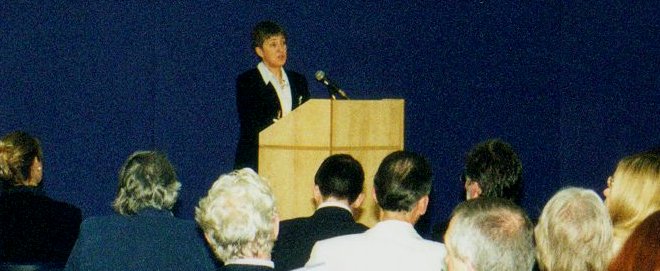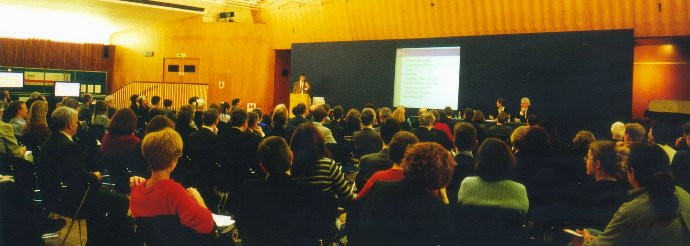RDN: Resource Discovery Network
Picture, just for a moment, a scholar wise in the books of the world but new to technology. Having heard about this 'Internet' business she goes to one of these search engines to try and find some resources relevant to her field of study. She offers the phrase 'medical ethics' (that being her field of study) to one rather garish and excitable search engine, but, after a delay of a few seconds, is proffered seemingly random links and enigmatic descriptions. One link's description asks 'Do We Still Need Doctors? (Price $17.50)', while another offers 'Information on how to work at home as a telecommuter.' Hmm. There is little here for the serious researcher.
As commentators on contemporary times have repeatedly pointed out, this is one of the symptoms of our technology-fuelled age - there exists a surfeit of available information, and thus separating the useful from the useless and creating a manageable amount of data is a prime concern. For those unable to find the resources that undoubtedly exist on the world wide web, help, in the shape of the Resource Discovery Network (RDN), is at hand. Located at the URL www.rdn.ac.uk [1], the RDN leads researchers, teachers and lecturers to a pre-existing catalogue of high-quality electronic resources. For example, inputting 'medial ethics' into the RDN's Resource Finder, our relieved scholar from above would find a much shorter but more relevant list of resources; links, for instance, to the Journal of Medical Ethics, and to documents on euthanasia, genetics and private health care.
Creating such an electronic catalogue, covering a wide range of subject-areas, is no simple task. It requires not only an array of specialists to analyse suitable resources, but technical skills to align catalogues from different subjects and, perhaps most importantly, the vision to allow such a network to flourish in an era of rapidly-changing information demands. With these obstacles successfully negotiated, the benefits for the potential user are enormous. It would go a long away to fulfilling the long-trumpeted possibilities of the Internet as a tool for uncovering resources vital for research and teaching.
These issues provided the theme for the official launch of the RDN. Held on the 19th November at the Congress Centre, near Tottenham Court Road, London, the launch offered various speeches, demonstrations, presentations and some top-class grub. Lynne Brindley, Pro-Vice-Chancellor (Communications and IT) at the University of Leeds opened the event, welcoming delegates, and giving an indication of the shaping factors in the development of the RDN. Pushed by the 1994 Follett Report, emphasising the possibilities of information technology in higher education, the Joint Information Systems Committee (JISC) soon created the eLib project. Within this were several subject gateways, including those for history, medicine and engineering. Though these gateways were successful, they had only limited funding and covered only a small percentage of human knowledge. Ms Brindley continued that the JISC rapidly saw the need for a much more extensive network of gateways. From this demand, the RDN was born. Funded by the JISC, with additional support from the Arts and Humanities Research Board and the Economic and Social Research Council, the RDN was to be led by two institutions, the University of Bath, and King's College, London.
Guest speaker Professor Howard Newby, currently President of the Committee of Vice-Chancellors and Principals, and a former Director of the ESRC Data Archive, placed Ms Brindley's address in a larger context, concentrating on the possibilities for new resource-finding tools such as the RDN. The RDN was in an excellent position to expand outside traditional boundaries. By continually seeking partnerships and users beyond Britain, and by stressing the potential of the RDN to institutions and bodies outside higher education, the network could create a wide stakeholding base to secure its place as an essential tool for high-quality resource discovery. And by developing relationships in the public and private sectors the RDN would be in an excellent position to support itself financially. Professor Newby completed his speech by formally launching the Resource Discovery Network.
Once these speeches had ended, glowing plasma screens positioned around the conference hall beckoned the assorted guests. These screens advertised the various 'hubs' that constitute the RDN, and were the centrepoint of each hub's exhibition stall. Interested delegates gathered around the screens for a demonstration to gain a better idea of the hubs' task within the network.
Initially, the RDN is, along with the central executive, constituted by five separate websites or 'hubs', each one of which covers a branch of human enquiry and learning. Visitors could therefore attend the stand for BIOME [ 2], the hub for the health and life sciences; EMC [3], the hub for engineering, mathematics and computing; Humbul [4], the hub for the humanities; PSIgate [5], the hub for the physical sciences; and SOSIG [6], the hub for the social sciences, business and law.
The hubs operate by employing subject specialists to catalogue and describe Internet resources relevant to their field. Compared to the varying descriptions given by the generic search engines, the RDN's hubs offer much more thoroughness, as each description summarises the resource's contents and gauges its accuracy and utility. The hubs also execute regular link-checks, measuring the resource's technical reliability and factual precision. This ensures that users are not forwarded to redundant sites and that the high standard of information is maintained.
Once the delegates had finished digesting the excellent lunch provided (many applauded the dim sum with hoy sin sauce), they had the opportunity to attend more formal presentations on the history, aims and objectives of each of the hubs. As regular readers of Ariadne will well be aware, some of these hubs, under the guise of the eLib project, existed in their own right for quite some time. SOSIG was one of them; EEVL another, having now melded with mathematics and computers to form the EMC hub. The one time OMNI gateway for biomedical resources has become part of a larger hub, BIOME. Humbul evolved separately, from the humanities bulletin board of the same name. Only PSIgate is a completely new hub. Plans are also afoot to develop a hub in the Creative Arts and Industries.
These presentations gave the hubs the opportunity to show the breadth of the area they are covering. Each hub can only hope to cover its field by carefully dividing their subject area and finding the relevant specialists for each domain. For example, BIOME contains five separate gateways - the pre-existing OMNI has been added to four new gateways, AgriFor (covering agriculture, forestry and food sciences), VetGate (covers all aspects of animal health) BioResearch (covering biological and biomedical research) and Natural Selection (covering the natural world). The new PSIgate hub will deal with astronomy, chemistry, physics, earth sciences and material sciences.
It was a central theme of the day's presentations that the hubs cannot hope to develop a thorough service if their connections remain only within their own university. Therefore, when it comes to organising subject specialists, the hubs have developed close links with other academic bodies. Humbul, which is based at the University of Oxford, have, amongst others, organised contacts at universities in Oslo and Liverpool (for theology and philosophy), and in California and London (for English literature). Hubs have also been quick to realise the importance of forging links with partners outside academia. Amongst the partners with whom BIOME have affiliations are the Natural History Museum and the Royal Free Hospital.
The presentation given by SOSIG emphasised the importance of hubs constructing their own identities and communities. SOSIG, like the other hubs, aim to do more than just provide a catalogue of resources. The 'Grapevine' section of their website offers the opportunity for dialogue between researchers and employers; the former can post their CVs on the site, while the latter can forward details of training and development opportunities. The site's (freely) registered members can also enter mailing forums for discussion and tailor the presentation of the site to their own needs.
Dragging the delegates in from the tea, coffee and buns provided in the foyer, the day ended with a speech by one of the RDN's co-directors, Lorcan Dempsey (also Director of the UK Office for Library and Information Networking). Mr Dempsey re-emphasised the philosophy underpinning the RDN, and showed how the network could hope to expand in the future.
One particular aspect of the RDN he expanded upon was the utilisation of search devices more sophisticated than the free text boxes which grace normal search engines, (although these are still present) to ensure that the specialised demands of researchers and lecturers are met. Thesaurus-based searching offers the user more precise or alternative terms than the one she has entered, giving the possibility of a broader search (should the user have been offered few hits) or a narrower one (should the user have received too many). EMC's subject gateway for engineering, EEVL, is one of many gateways that allows users to search the catalogue via their specialised subject. Once the user has selected, for instance, chemical engineering, she can then further specify what type of resource she is searching for - library catalogues, patents and standards, databases, or mailing lists are a few of the available categories. The user can also further differentiate between subject areas to provide an even more exacting search. Chemical engineers can search filtered catalogues, for example, relating to 'chemical engineering processes' or 'chemical engineering science'. Of course, the process can work the other way. While some searches demand precision along subject lines, other users require searches working across several subject catalogues. When our scholar interested in medical ethics conducted her search, the final result drew in resources from both BIOME and SOSIG. Now academic work is increasingly done at an inter-disciplinary level, the RDN's ability to overlap two or more different hubs will be an important factor for users.
With this final point, the launch party of the Resource Discovery Network ended. PowerPoint was exited, terminals were switched off, plasma screens ceased to glow. The RDN had been presented - its past, its hubs, its aims, its future - and the delegates departed knowing they now had secure directions to navigate the confusion of the Internet.
For more information on the Resource Discovery Network please contact:
- Justine Kitchen
- Information and Training Officer
- Resource Discovery Network Centre
- King's College London
- Strand
- London WC2R 2LS
- Tel: +44 (0)171 848 2935
- Fax: +44 (0)171 848 2939
- Email: justine.kitchen@rdn.ac.uk
- Or visit our website at http://www.rdn.ac.uk
- Alastair Dunning
- Outgoing Information and Training Manager
- alastair.dunning@courtauld.ac.uk
Photographs by Philip Hunter, UKOLN
References
- 1. The Resource Discovery Network
- http://www.rdn.ac.uk
- 2. BIOME, the hub for the health and life sciences
- http://biome.ac.uk
- 3. EMC, the hub for engineering, mathematics and computing
- http://www.emc.ac.uk
- 4. Humbul, the hub for the humanities
- http://www.humbul.ac.uk
- 5. PSIgate, the hub for the physical sciences
- http://www.psigate.ac.uk
- 6. SOSIG, the hub for the social sciences, business and law
- http://www.sosig.ac.uk
